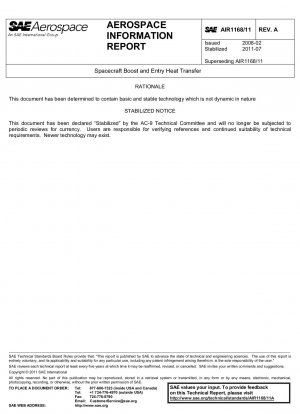SAE AIR1168/11A-2011
Spacecraft Boost and Entry Heat Transfer
- Standard No.
- SAE AIR1168/11A-2011
- Release Date
- 2011
- Published By
- Society of Automotive Engineers (SAE)
- Latest
- SAE AIR1168/11A-2011
- Scope
- The prediction of vehicle temperatures during ascent through the earth's atmosphere requires an accurate knowledge of the aerodynamic heating rates occurring at the vehicle surface. Flight parameters required in heating calculations include the local airstream velocity, pressure, and temperature at the boundary layer edge for the vehicle location in question. In addition, thermodynamic and transport air properties are required at these conditions. Both laminar and turbulent boundary layers occur during the boost trajectory. Experience has shown that laminar and turbulent heating are of equivalent importance. Laminar heating predominates in importance in the stagnation areas, but the large afterbody surfaces are most strongly affected by turbulent heating. Once the local flow conditions and corresponding air properties have been obtained, the convective heating rate may be calculated for a particular wall temperature. This assumes that the boundary layer flow regime (that is, turbulent, laminar, or transitory) has also been established, so that a heating theory corresponding to the particular flow conditions may be selected. This section presents theoretical methods for computing boost vehicle surface aerodynamic heating rates. First, procedures are given for computing the local flow distributions around the vehicle. Second, methods are given for computing the convective heating rates, using the flow parameters found previously.
SAE AIR1168/11A-2011 history
- 2011 SAE AIR1168/11A-2011 Spacecraft Boost and Entry Heat Transfer

SAE AIR1168/11A-2011 -All Parts
SAE AIR1168/1-2011 Thermodynamics of Incompressible and Compressible Fluid Flow
SAE AIR1168/10-2011 THERMOPHYSICAL CHARACTERISTICS OF WORKING FLUIDS AND HEAT TRANSFER FLUIDS
SAE AIR1168/10A-2017 Thermophysical Characteristics of Working Fluids and Heat Transfer Fluids
SAE AIR1168/11-2008 Spacecraft Boost and Entry Heat Transfer
SAE AIR1168/11A-2011 Spacecraft Boost and Entry Heat Transfer
SAE AIR1168/12-2004 Spacecraft Thermal Balance
SAE AIR1168/12A-2011 Spacecraft Thermal Balance
SAE AIR1168/13-2006 Spacecraft Equipment Environmental Control
SAE AIR1168/13A-2011 Spacecraft Equipment Environmental Control
SAE AIR1168/14-2011 Spacecraft Life Support Systems
SAE AIR1168/14A-2012 Spacecraft Life Support Systems
SAE AIR1168/1A-2019 Thermodynamics of Incompressible and Compressible Fluid Flow
SAE AIR1168/2-2007 Heat and Mass Transfer and Air-Water Mixtures
SAE AIR1168/2A-2011 Heat and Mass Transfer and Air-Water Mixtures
SAE AIR1168/3-2011 Aerothermodynamic Systems Engineering and Design
SAE AIR1168/3A-2019 SAE Aerospace Applied Thermodynamics Manual Aerothermodynamic Systems Engineering and Design
SAE AIR1168/4-2004 Ice, Rain, Fog, and Frost Protection
SAE AIR1168/4A-2014 SAE Aerospace Applied Thermodynamics Manual Ice, Rain, Fog, and Frost Protection
SAE AIR1168/4B-2016 SAE Aerospace Applied Thermodynamics Manual Ice@ Rain@ Fog@ and Frost Protection
SAE AIR1168/4C-2021 SAE Aerospace Applied Thermodynamics Manual Ice, Rain, Fog, and Frost Protection
SAE AIR1168/5-2006 Aerothermodynamic Test Instrumentation and Measurement
SAE AIR1168/5A-2011 Aerothermodynamic Test Instrumentation and Measurement
SAE AIR1168/6-2004 Characteristics of Equipment Components, Equipment Cooling System Design, and Temperature Control System Design
SAE AIR1168/6A-2011 Characteristics of Equipment Components@ Equipment Cooling System Design@ and Temperature Control System Design
SAE AIR1168/7-2004 Aerospace Pressurization System Design
SAE AIR1168/7A-2011 Aerospace Pressurization System Design
SAE AIR1168/8-2004 Aircraft Fuel Weight Penalty Due to Air Conditioning
SAE AIR1168/8A-2011 Aircraft Fuel Weight Penalty Due to Air Conditioning
SAE AIR1168/9-2004 Thermophysical Properties of the Natural Environment, Gases, Liquids, and Solids
SAE AIR1168/9A-2011 Thermophysical Properties of the Natural Environment, Gases, Liquids, and Solids